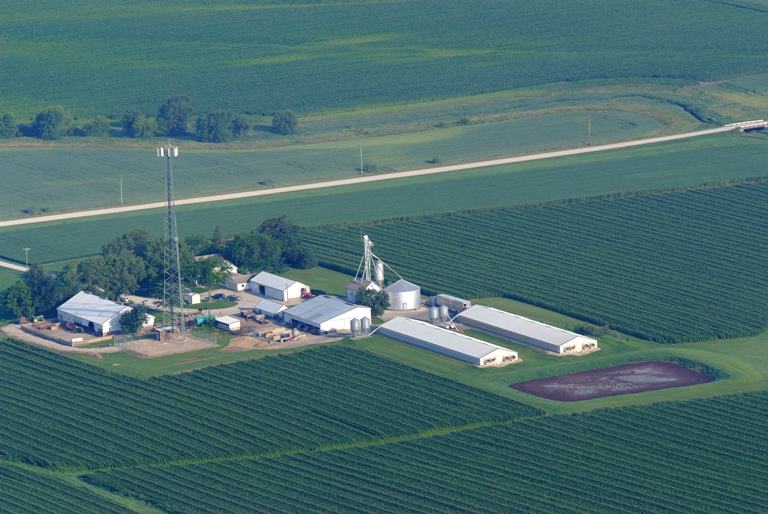Study Shows Consumer Food Costs Could Rise with U.S. Livestock Industry Relocation, Reduction
The United Soybean Board (USB) announced the results of a soy- checkoff-funded study that concludes there could be a significant potential impact to consumers if the U.S. poultry and livestock sectors are relocated or reduced in response to animal-housing regulations. The press conference to unveil the study results was held March 2 at Commodity Classic in Nashville, TN. A report on the recently released study was compiled by Susan Winsor, Managing Editor of National Hog Farmer’s sister publication, Corn & Soybean Digest.
March 2, 2012

Regulations on the soybean industry’s biggest customer – the U.S. livestock industry – could add more than $16.8 billion annually to U.S. consumers’ grocery bill. So says a study funded by the United Soybean Board (USB) if regulations are imposed on U.S. poultry and livestock sectors that raise input costs by 25%, the study finds.
For example, group animal-housing regulations, on layer-hen cages, veal stalls and sow-gestation crates, could increase the retail price of a dozen eggs by 25%, or 42¢, from $1.68 to $2.10, the study says. This could result from converting to cage-free egg production, raising infrastructure requirements, decreasing potential production and steeper variable costs of production, the study finds. The overall cost to consumers would be $2.66 billion annually, due mostly to significantly higher feed requirements, labor requirements and lower egg yields.
The study estimates that the increased costs of retrofitting and complying with pig housing regulations would increase costs by 5-10%. “In some instances, these increased costs would be placed upon industries that have lost significant amounts of money over the past three years, paving the way for further decreased supplies and increased costs to consumers over the long term. (New facilities, which would be designed to meet the regulations from the outset, might cost 1-2% more/year to build and operate)”, the study says.
Infrastructural changes can be significant. J.S. West, one of the largest egg producers in California, spent $3.2 million upgrading housing in one of its 15 hen houses, the study says. Infrastructure changes for all the company’s facilities would total about $50 million for uniform conversion to Enriched Colony Systems, but it is still not at all clear that such systems even fulfill the future new law requirements, the study says.
Several states will ban sow-gestation crates, veal stalls and/or conventional cage systems for layer hens beginning in 2008 (Florida) through 2019 (Michigan). Other states with related regulations pending are Arizona, Oregon, California, Colorado and Maine, the report says.
U.S. livestock is by far the major source of demand for U.S. corn and soybean meal, and future demand for them is tightly linked to the economic health of these livestock and poultry industries. Increased regulation can result in higher consumer costs by either requiring capital investment or specific production methods that involve higher ongoing expenditures for labor or other inputs, or by causing firms to exit the industry, reducing supply, the USB study finds.
For example, Mexico is potentially well positioned to supply eggs to the U.S., says USB Chair and Colfax, ND, farmer Vanessa Kummer, based on her travels there. The study did not focus on this specifically, but her personal observations also indicate that Brazil is well positioned to enlarge its growing feed and livestock industry if U.S. livestock regulations weaken the domestic industry’s competitiveness, she said in a news conference at the 2012 Commodity Classic in Nashville. She was asked where the most likely livestock production would be if U.S. livestock production moved offshore in response to burdensome regulations and higher costs.
One audience observer likened the potential from pending regulations to the offshoring of U.S. oil-refining capacity in response to more U.S. regulations.
Consumer and economic impact
Using a conventional economic model, the study estimated the consumer cost impact of higher production costs for U.S. pork, beef, chicken, turkey and eggs that could result from an increased regulatory burden from various sources. It looked at two scenarios: increases of 10% and 25% in production costs for each product.
It estimates that the additional cost to U.S. consumers would be $6.8 billion and $16.8 billion/year, respectively, for the two scenarios.
In addition, in the 25%-production-cost-increase scenario, there would be a reduction in net exports of $1.1 billion that would in turn eliminate about 9,000 jobs, the study finds.
In 2009-2010, U.S. livestock consumed 27 million metric tons (mmt) of soybean meal, 137 mmt of corn and other feedgrains and 39 mmt of corn byproducts like DDGs and corn gluten feed and meal. Soybean meal, the principal driver of soybean processing, produces the soybean oil essential for the U.S. food industry.
Actions to maintain and expand animal agriculture in the U.S. by supporting its long-term competitiveness are of critical importance to U.S. crop farmers and the health of rural America, USB says.
Animal agriculture, encompassing mainly U.S. beef cattle, hogs, broilers, turkeys, eggs, sheep, dairy and aquaculture had the following positive national economic impacts in 2010, the study says:
· 1,853,013 Job impact throughout U.S. economy
· $289 billion economic impact on total U.S. economy
· $51 billion impact on household incomes
· $13 billion impact on income taxes paid
· $6 billion impact on property taxes paid
Read the complete report at the United Soybean Board Web site at http://www.unitedsoybean.org/wp-content/uploads/Consumer-and-Food-Safety-Costs-of-Offshoring-Animal-Agriculture.pdf.
Learn more about current soybean industry news at the Corn & Soybean Digest Web site at http://cornandsoybeandigest.com.
You May Also Like



